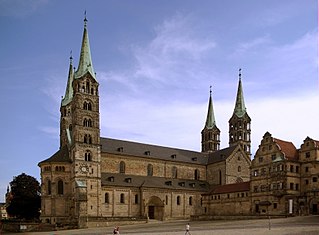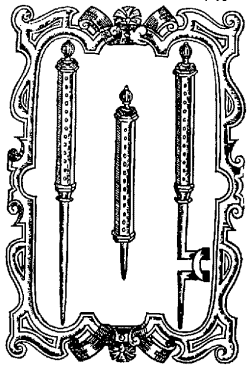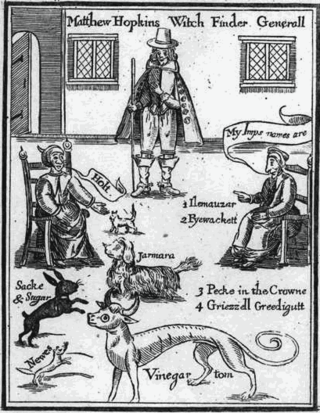
A witch-hunt, or a witch purge, is a search for people who have been labeled witches or a search for evidence of witchcraft. The classical period of witch-hunts in Early Modern Europe and Colonial America took place in the Early Modern period or about 1450 to 1750, spanning the upheavals of the Reformation and the Thirty Years' War, resulting in an estimated 35,000 to 50,000 executions. The last executions of people convicted as witches in Europe took place in the 18th century. In other regions, like Africa and Asia, contemporary witch-hunts have been reported from sub-Saharan Africa and Papua New Guinea, and official legislation against witchcraft is still found in Saudi Arabia and Cameroon today.
In England, Scotland, Wales, and Ireland, and the British colonies, there has historically been a succession of Witchcraft Acts governing witchcraft and providing penalties for its practice, or—in later years—rather for pretending to practise it.
In the early modern period, witch trials were seen between 1400 and 1782, where around 40,000 to 60,000 were killed due to suspicion that they were practicing witchcraft. These trials occurred primarily in Europe, and were particularly severe in some parts of the Holy Roman Empire. Some witch-hunts would last for years, and some sources estimate 100,000 trials occurred. Groundwork on the concept of witchcraft was developed by Christian theologians as early as the 13th century. However, prosecutions for the practice of witchcraft reached a high point only from 1560 to 1630 during the Counter-Reformation and the European wars of religion, with some regions burning at the stake those who were convicted, of whom roughly 80% were women, mostly over the age of 40.

The Witch trials of Fulda in Germany from 1603 to 1606 resulted in the death of about 250 people. They were one of the four largest witch trials in Germany, along with the Trier witch trials, the Würzburg witch trial, and the Bamberg witch trials. The persecutions were ordered by the Catholic Prince Bishop, a follower of the Counter-Reformation. Crypto-protestants were executed on charges of witchcraft.

The Bamberg witch trials of 1627–1632, which took place in the self-governing Catholic Prince-Bishopric of Bamberg in the Holy Roman Empire in present-day Germany, is one of the biggest mass trials and mass executions ever seen in Europe, and one of the biggest witch trials in history.
The Great Scottish Witch Hunt of 1597 was a series of nationwide witch trials that took place in the whole of Scotland from March to October 1597. At least 400 people were put on trial for witchcraft and various forms of diabolism during the witch hunt. The exact number of those executed is unknown, but is believed to be about 200. The Great Scottish Witch Hunt of 1597 was the second of five nationwide witch hunts in Scottish history, the others being The Great Scottish Witch Hunt of 1590–91, The Great Scottish Witch Hunt of 1628–1631, The Great Scottish witch hunt of 1649–50 and The Great Scottish Witch Hunt of 1661–62.
The Channel Islands Witch Trials were a series of witch trials in the Channel Islands of Jersey and Guernsey between 1562 and 1661.

In early modern Scotland, in between the early 16th century and the mid-18th century, judicial proceedings concerned with the crimes of witchcraft took place as part of a series of witch trials in Early Modern Europe. In the late middle age there were a handful of prosecutions for harm done through witchcraft, but the passing of the Witchcraft Act 1563 made witchcraft, or consulting with witches, capital crimes. The first major issue of trials under the new act were the North Berwick witch trials, beginning in 1590, in which King James VI played a major part as "victim" and investigator. He became interested in witchcraft and published a defence of witch-hunting in the Daemonologie in 1597, but he appears to have become increasingly sceptical and eventually took steps to limit prosecutions.

The great Scottish witch hunt of 1649–50 was a series of witch trials in Scotland. It is one of five major hunts identified in early modern Scotland and it probably saw the most executions in a single year.

Sweden was a country with few witch trials compared to other countries in Europe. In Sweden, about four hundred people were executed for witchcraft prior to the last case in 1704. Most of these cases occurred during a short but intense period; the eight years between 1668 and 1676, when the witch hysteria called det stora oväsendet took place, causing a large number of witch trials in the country. It is this infamous period of intensive witch hunt that is most well known and explored and given attention.

In the Holy Roman Empire, witch trials composed of the areas of present-day Germany, Switzerland and Austria, were the most extensive in Europe and in the world, both to the extent of the witch trials as such as well as to the number of executions.

The Witch trials in Denmark are poorly documented, with the exception of the region of Jylland in the 1609–1687 period. The most intense period in the Danish witchcraft persecutions was the great witch hunt of 1617–1625, when most executions took place, which was affected by a new witchcraft act introduced in 1617.
The witch trials in the Netherlands were among the smallest in Europe. The Netherlands are known for having discontinued their witchcraft executions earlier than any other European country. The provinces began to phase out capital punishment for witchcraft beginning in 1593. The last trial in the Northern Netherlands took place in 1610.
The witch trials in Poland started later than in most of Europe, beginning in earnest in Poland until the second half of the 17th century, but also lasted longer than elsewhere. Despite being formally banned in 1776, the law was not evenly enforced for the next half a century even after the witch trials had ended or became a rarity in the rest of Europe. It is estimated that between 3,000 and 4,000 people have been executed for sorcery in Poland.
The Witch trials in Hungary were conducted over a longer period of time than in most countries in Europe, as documented witch trials are noted as early as the Middle Ages, earlier than common, and lasted until the late 18th-century, which was later than normal. During the 16th and 17th centuries Hungary was divided into three parts: Austrian Hungary, Ottoman Hungary and Transylvania, with some differences between them in regard to the witch hunt. The most intense period of witch hunt in Hungary took place in the 18th-century, at a time when they were rare in the rest of Europe except Poland. The trials finally stopped in 1768 by abolition of the death penalty for witchcraft by Austria, which controlled Hungary at the time. An illegal witch trial and execution took place in 1777.

In England, witch trials were conducted from the 15th century until the 18th century. They are estimated to have resulted in the death of perhaps 500 people, 90 percent of whom were women. The witch hunt was at its most intense stage during the English Civil War (1642–1651) and the Puritan era of the mid-17th century.
The Witch trials in the Italian states of present-day Italy are a complicated issue. Witch trials could be managed by a number of different secular courts as well as by the Roman Inquisition, and documentation has been only partially preserved in either case. A further complication is the fact that Italy was politically split between a number of different states during the time period in which the witch trials occurred; and that historiography has traditionally separated the history of Northern Italy and Southern Italy. All of these issues complicate the research of witch trials in present-day Italy, and the estimations of the intensity and number of executions has varied between hundreds to thousands of victims.

The Baden-Baden witch trials took place in Baden-Baden in Germany between 1627 and 1631. These witch trials resulted in the deaths of over 200 people; the exact number are uncertain. The trials belonged to the great wave of witch-hunting that took place in southwestern Germany during the Thirty Years' War.
The Normandy witch trials of 1669-1670, which took place in the province of Normandy in France, belong to the most famed of French witch hunts. In parallel with the witch trials of Guyenne and Bearn in 1670-72, it was one of the two last great witch hunts in France. It has an important role in the history of French witch trials, because together with the witch trials of Guyenne and Bearn, it resulted in an intervention from king Louis XIV of France, who stopped them, and introduced an edict designed to limit the persecution of witchcraft in France.
Witch trials took place in the Principality of Catalonia in Spain between the 14th-century and 1767. Witch trials were comparably uncommon in Spain, and most of them took place in Catalonia and Navarre. While witch trials were uncommon in the rest of Spain, the witch trials in Catalonia had similarities with the witch trials in the rest of Western Europe, and are therefore a separate chapter in the context of witch trials in Spain. Around 400 women were prosecuted for witchcraft in Catalonia.








